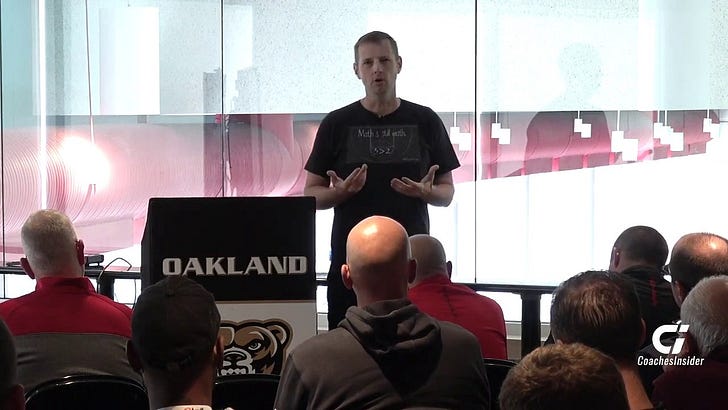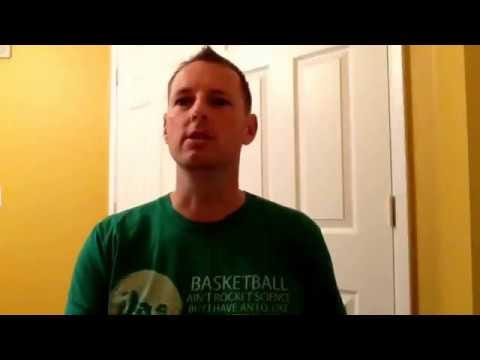Notes from a Clinic: Playmakers Leagues
The history, philosophy, and concepts behind one of the few development-focused youth basketball leagues.
I presented about Playmakers Leagues at the United Bball+ clinic at the Hoosiers Gym in Indiana. The attendees were high school and college coaches, and I shaped my presentation to peak their interest in the Playmakers League as feeder programs for their high schools.
First, I explained the history, and the reasons I founded Playmakers League initially. Playmakers League arose out of three practical reasons: First, coaches contacted me and asked for more specific information after I published Cross Over: The New Model of Youth Basketball Development. They appreciated the philosophy, but wanted a more specific action plan. Blitz Basketball was the first attempt to create a specific system to embrace the Cross Over model and was followed by 180 Shooter and Hard2Guard: Skill Development for Perimeter Players, which detailed the technical skills. Then, I wrote Developing Basketball Intelligence to focus more on the tactical skills.
Second, I wanted to experiment with different ways to sell books after writing DBI. I sold several group purchases shortly after publishing Cross Over; I believe Basketball British Columbia ordered in the hundreds for their coaches, and the Suwanee Sports Complex and I created a Suwanee-branded version with an order of 500. I wrote Playmakers as a player’s version of DBI, and the Playmakers League was initially a sales tool: I gave away the curriculum to coaches who bought copies of Playmakers for each participant.
Third, as a junior college assistant coach, I was paid $2500 for the season, I believe, which was a raise from my first college job, in which I was paid $500 for the season, plus occasional free burritos. I was allowed to use the gym at the junior college on weekends, as we played on Friday nights and rarely practiced on weekends. I started an AAU league that attracted several big name clubs from throughout southern California with teams from south Orange County, San Gabriel Valley, and San Fernando Valley traveling to play in West Los Angeles. At the end of the league, I realized I barely made any money for what was a lot of work, and most of the revenue went to the referees. I would have made more money had I just refereed a game or two each weekend in someone else’s league. Playmakers League was an attempt to create a league for high school or college coaches to operate to retain most of the revenue without having to plan clinics or practices for youth players in addition to their college or high school practices, scouting, recruiting, and more.
Playmakers Leagues were designed as a practical way to implement the long term development model from Cross Over, focusing on the technical and tactical skills from Hard2Guard and DBI; sell Playmakers to players; and generate income for near-volunteer high school and college coaches and assistants who had access to gyms. The biggest hurdle faced by coaches attempting to start a Playmakers League was parents saying three-vs-three was not real basketball.
A year or two after starting Playmakers Leagues, I returned to school to pursue my doctorate. I decided to study three-vs-three as my project. My department focused heavily on increasing physical activity in children, and my study of three-vs-three was designed around these objectives. The initial question was to compare the moderate to vigorous physical activity of three-vs-three half-court games to five-vs-five full-court games, as these were the two most common game forms, especially as FIBA 3X3 had started.
We found three-vs-three provided as much or more moderate to vigorous physical activity as the five-vs-five games, and we found players had more meaningful touches and defensive possessions. The meaningful offensive touches were opportunities in the half-court or under pressure; a player inbounding in the full-court with no defensive pressure was not counted. Meaningful defensive possessions were guarding the ball or actively playing help defense; standing near a stationary player in the opposite corner did not count. Additionally, we found that ball possessions equaled out between positions in three-vs-three compared to five-vs-five; point guards had significantly more possessions than other positions in five-vs-five, but the differences were much smaller in three-vs-three.
After the study, Playmakers League became as much about promoting play and three-vs-three as it was an actual business selling books and leagues. Three-vs-three was very much real basketball, and in many ways, a better version developmentally.
Coaches contacted and suggested the original curriculum was often too advanced for beginning players, so I wrote two additional curriculums and created a layered curriculum for players to move from beginner through organized three-vs-three play to prepare for eventual five-vs-five leagues. Along with the new curriculums, the web site began promoting all forms of rule modification, especially basket height and ball size, and I and a doctoral student at University of Georgia attempted to find funding to study basket height and ball size in more depth, but the funding was never approved.
There is no skill in five-vs-five that cannot be practiced in three-vs-three. Truthfully, every general skill is available in two-vs-two; you can practice screens in a pick-and-roll or a dribble handoff in two-vs-two, although the more specific off-ball screen requires three players (passer, cutter, screener). The general skill of screening and the general skill of using a screen can be introduced through two-vs-two play. Therefore, with all the advantages, the naysayers have no legitimate argument about the reality of three-vs-three basketball: It achieves the same or better levels of physical activity, increases, ball contacts, shot attempts, and more, and includes every skill used in a five-vs-five game.
Similarly, age-appropriate basket heights and ball sizes do not move the game away from the adult game, but closer to the adult game, as the improved shooting or threat of shooting improves spacing, presents more driving lanes, improves shooting percentages, and more.
Players sign up to play basketball, to possess the ball, to shoot. Nobody signs up to stand under the basket and rebound for their teammates or to stand in the corner out of the way of their teammates. Sacrifice, discipline, teamwork, and all of the other things we hope to build in players in the long run, and which we see in elite teams, have their time and place, but they are not as important for young players as developing a love for playing the game, familiarity and confidence with the ball, friendships, a desire for physical activity, and the joy from enjoying the experience and wanting to continue. Playmakers Leagues focus on these first to prepare players for the more advanced skills and intangibles later. As Cross Over emphasized, coaches do not need to practice or attempt to perfect every skill and every idea with every age or team; players and skills can build over time.
I showed a few drills to demonstrate the basic ideas. I referenced the college team there to demonstrate, as they did a standard dynamic warmup when they arrived. Children do not necessarily need a dynamic warmup, and my purpose for a dynamic warmup is to teach basic skills and movements, not necessarily to warm up. Instead, we use warmups such as the Free Dribble Warmup, and then move to tag.
I explained the benefits of not using elimination games, as typically the players who need the most repetitions are eliminated first, and the players who are already better receive more repetitions as they are eliminated last. I demonstrated Team Tag and Team Tag Relay to illustrate the difference between an elimination game and a non-elimination game.
Next, I demonstrated Rock-Paper-Scissors Tag as an example of a fun game to use for conditioning purposes. Children will play RPS Tag for 30 minutes without realizing all they are doing is running. There are other variations of the same idea.
I demonstrated Getup Tag at a school when I coached in Ireland, and the P.E. teachers were amazed at the intensity of activity and the attention from all of the students, as they essentially did nothing more than run and chase each other for 20 minutes with no complaints, nobody asking to sit out, and more.
Next, I showed examples of layup drills involving more players and balls, speed and competition than a standard pregame layup drill.
Finally, I demonstrated Volleyball Passing, and then 5v4 Advantage Passing as examples of passing drills.
Advantage Passing was used as an example of regression to a slightly easier drill based on skill level or performance.
Then, I demonstrated the Hard2Guard Drill, as several players passed lazily without pivoting.
I explained my style of coaching, starting with something close to the game or the actual game, and then regressing to a specific drill to practice a specific skill or habit.
This was a short presentation on some basic ideas that summarize the Playmakers League’s philosophy, which developed from the original Cross Over: The New Model of Youth Basketball Development philosophy. Our goal now with Playmakers League continues to be promoting better models, systems, and coaching, especially for youth players, and assisting coaches who want to bring Playmakers Leagues, and enhanced development, to their cities, neighborhoods, and schools.





